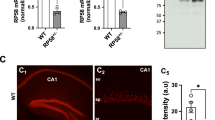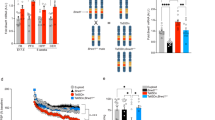Abstract
Trisomy 21 or Down syndrome (DS) is the most frequent genetic cause of mental retardation, affecting one in 800 live born human beings. Mice with segmental trisomy 16 (Ts65Dn mice) are at dosage imbalance for genes corresponding to those on human chromosome 21q21–22.3—which includes the so–called DS ‘critical region’. They do not show early–onset of Alzheimer disease pathology; however, Ts65Dn mice do demonstrate impaired performance in a complex learning task requiring the integration of visual and spatial information. The reproducibility of this phenotype among Ts65Dn mice indicates that dosage imbalance for a gene or genes in this region contributes to this impairment. The corresponding dosage imbalance for the human homologues of these genes may contribute to cognitive deficits in DS.
This is a preview of subscription content, access via your institution
Access options
Subscribe to this journal
Receive 12 print issues and online access
$209.00 per year
only $17.42 per issue
Buy this article
- Purchase on Springer Link
- Instant access to full article PDF
Prices may be subject to local taxes which are calculated during checkout
Similar content being viewed by others
References
Hook, E.B. in Trisomy 21 (Down Syndrome): Research Perspectives (eds. Cruz, F.F.d.l. & Gerald, P.S.) 3–68 (Universwity Park Press, Baltimore, 1981).
Coyle, J.T., Oster-Granite, M.L. & Gearhart, J.D. The neurobiologic consequences of Down Syndrome. Brain Res. Bull. 16, 773–787 (1986).
Crome, R., Cowie, V. & Slater, E. A statistical note on cerebellar and brain-stem weight in Down Syndrome. J. ment. Def. Res. 10, 69–72 (1966).
Solitaire, G. & Lamarche, J. Alzheimer's disease and senile dementia as seen in Mongoloids: neuropathological observations. Am. J. ment. Def. 70, 840–848 (1966).
Haberland, C. Alzheimer's disease in Down syndrome. Acta Neurol. Belgium 69, 369–380 (1969).
Ellis, W.G., McCulloch, J.R. & Corley, C.L. Presenile dementia in Down syndrome. Ultrastructural identity with Alzheimer's disease. Neurology 24, 101–106 (1974).
Burger, P.C. & Vogel, F.S. The development of the pathologic changes of Alzheimer's disease and senile dementia in patients with Down's syndrome. Am. J. Path. 73, 457–476 (1973).
Weisnewski, K.E., Weisnewski, M.H. & Wen, G.Y. Occurence of neuropathological changes and dementia of Alzheimer's disease in Down's syndrome. Ann. Neurol. 17, 278–282 (1985).
Korenberg, J. et al. Down syndrome phenotypes: The consequences of chromosomal imbalance. Proc. natn. Acad. Sci. U.S.A. 91, 4997–5001 (1994).
McCormick, M.K. et al. Molecular approach to the characterization of the Down syndrome region of chromosome 21. Genomics 5, 325–331 (1989).
Rahmani, Z. et al. Critical role of the D21S55 region on chromosome 21 inthe pathogenesis of Down Syndrome. Proc. natn. Acad. Sci. U.S.A. 86, 5958–5962 (1989).
Reeves, R.H. & Citron, M.P., Chromosome 16. Mamm. Genome 5, S229–S237 (1994).
Epstein, C.J., Cox, D.R. & Epstein, L.B. Mouse trisomy 16: An animal model for human trisomy 21 (Down's syndrome). Ann. N. Y. Acad. Sci. 450, 157–177 (1985).
Davisson, M.T., Schmidt, C. & Akeson, E. Segmental trisomy of murine chromosome 16: A new model system for studying Down Syndrome. Prog. clin. biol. Res. 360, 263–280 (1990).
Davisson, M.T. et al. Segmental trisomy as a mouse model for Down Syndrome. Prog. clin. biol. Res. 384, 117–133 (1993).
Dietrich, W.F. et al. A genetic map of the mouse with 4,006 simple sequence length polymorphisms. Nature Genet. 7, 220–225 (1994).
Bendotti, C. et al. Neuroanatomical localization and quantification of cerebrovascular amyloid peptide RNA following in situ hybridization in the brains of normal, aneuploid, and experimentally lesioned mice. Proc. natn. Acad. Sci. U.S.A. 85, 3628–3632 (1988).
Gearhart, J. et al. Mouse chimeras composed of trisomy 16 and normal (2N) cells: Preliminary studies. Brain Res. Bull. 16, 815–824 (1986).
Sanberg, P., Moran, T. & Coyle, J. in Experimental models of dementing disorders: A synaptic neurochemicalperspective (ed. Coyle, J.) 253–278 (AlanLiss, Inc., 1987).
Guilarte, T., Miceli, R. & Moran, T. Developmental effects of vitamin B-6 restriction on the locomotor behavior of rats. Brain Res. Bull. 34, 31–40 (1991).
Bautista, J., Schwartz, G., dela Torre, D., Moran, T. & Carbone, K. Early and persistent abnormalities in rats with neonatally acquired Borna disease virus infection. Brain Res. Bull. 34, 31–40 (1994).
Delaber, J.-M. et al. Report of the fourth international workshop on human chromosome 21. Genomics 18, 735–744 (1993).
Cox, D.R., Burmeister, M., Price, E.R., Kim, S. & Myers, R.M. Radiation hybrid mapping: A somatic cell genetic method for constructing high resolution maps of mammalian chromosomes. Science 250, 245–250 (1990).
Cheng, S.V. et al. Comparative mapping of DNA markers from the familial Alzheimer disease and Down syndrome regions of chromosome 21 to mouse chromosomes 16 and 17. Proc. natn. Acad. Sci. U.S.A. 85, 6032–6036 (1988).
Miyabara, S., Gropp, A. & Winking, H. Trisomy 16 in the mouse fetus associated with generalized edema and cardiovascular and urinary tract anomalies. J. exp. Zool. 228, 253–269 (1983).
Bucan, M. et al. Comparative mapping of 9 human chromosome 22q loci in the laboratory mouse. Hum. molec. Genet. 2, 1245–1252 (1993).
Goldmuntz, E. et al. Microdeletions of chromosomal region 22q11 in patients with congenital conotruncal cardiac defects. J. med. Genet. 30, 807–812 (1993).
Wisniewski, K.E., Dalton, A.J., Crapper-McLachlan, D.R., Wen, G.Y. & Wisniewski, H.M. Alzheimer's disease in Down syndrome: clinicopathologic studies. Neurology 35, 957–961 (1985).
Goldgaber, D., Lerman, M.I., McBride, W.O., Saffiotti, U. & Gajdusek, D.C. Characterization and chromosomal location of a cDNA encoding brain amyloid of Alzheimer's disease. Science 235, 877–880 (1987).
Tanzi, R.E. et al. Amyloid beta protein gene: cDNA, mRNA distribution and genetic linkage near the Alzheimer locus. Science 235, 880–884 (1987).
Goate, A. et al. Segregation of a missense mutation in the amyloid precursor protein gene with familial Alzhemers disease. Nature 349, 704–706 (1991).
Mullan, M. et al. A pathogenic mutation for probable Alzheimer's disease in the APP gene at the N-terminus of B-amyloid. Nature Genet. 1, 345–347 (1992).
Lamb, B.T. et al. Introduction and expression of the 400 kilobase amyloid precursor protein gene in transgenic mice. Nature Genet. 5, 22–30 (1993).
Games, D. et al. Alzheimer-type neuropathology in transgenic mice overexpressing V717F b-amyloid precursor protein. Nature 373, 523–527 (1995).
Morris, R., Garrud, P., Rawlins, J. & O'Keefe, J. Place navigation impaired in rats with hippocampal lesions. Nature 297, 681–683 (1982).
Wishart, J. in The Psychobiology of Down Syndrome (ed. Nadel, L) 7–50 (M.I.T. Press, Cambridge, 1988).
Pueschel, S. in The Psy chobiology of Down Syndrome (ed. Nadel, L.) 199–216 (M.I.T. Press, Cambridge, 1988).
Marcel, M. & Armstrong, V. Auditory and visual sequential memory of Down Syndrome and nonretarded children. Am. J. ment. Def. 87, 86–95 (1982).
Cabin, D.E., Hawkins, A., Griffin, C. & Reeves, R. HYAC transgenic mice in the study of the genetic basis of Down syndrome. Progr. cin. biol. Res. 393, 213–226 (1995).
Davisson, M.T. & Akeson, E.C. An improved method for preparing G-banded chromosomes from mouse peripheral blood. Cytogenet. Cell Genet. 45, 70–74 (1987).
Pittler, S. & Baehr, W. Identification of a nonsense mutation in the rod photoreceptor cGMP phosphodiesterase b-subunit of the rd mouse. Proc. natn. Acad. Sci. U.S.A. 88, 8322–8326 (1991).
Kao, F.T. & Puck, K.T. Genetics of somatic mammalina cells, VII. Induction and isolation of nutritional mutants in Chinese hamster cells. Proc. natn. Acad. Sci. U.S.A. 60, 1275–1281 (1975).
Reeves, R.H. et al. Genetic linkage in the mouse of genes involved in Down syndrome and Alzheimers disease in man. Molec. Brain Res. 2, 215–221 (1987).
O'Hara, B.F., Fisher, S., Oster-Granite, M.L., Gearhart, J.D. & Reeves, R.H. Developmental expression of the amyloid precursor protein, growth-associated protein 43, and somatostatin in normal and trisomy 16 mice. Dev. Brain Res. 49, 300–304 (1989).
O'Hara, B.F. et al. Genetic mapping and analysis of somatostatin expression in snell dwarf mice. Molec. Brain Res. 4, 283–292 (1988).
Camper, S.A., Saunders, T.L., Katz, R.W. & Reeves, R.H. The Pit-1 transcription factor gene is a candidate for the murine Snell dwarf mutation. Genomics 8, 586–590 (1990).
Mjaatvedt, A., Citron, M.P. & Reeves, R.H. High resolution mapping of D16Led1, Gart, Gas-4, Cbr, Pcp-4, and Erg on mouse chromosome 16. Genomics 17, 382–386 (1993).
Irving, N.G., Hardy, J.A. & Brown, S.D.M. The multipoint genetic mapping of mouse chromosome 16. Genomics 9, 386–389 (1991).
Gregor, P. et al. Chromosomal localization of glutamate receptor genes: relationship to familial amyotrophic lateral sclerosis and other neurological disorders of mice and man. Proc. natn. Acad. Sci. U.S.A. 90, 3053–3057 (1993).
Epstein, C.J. et al. Transgenic mice with increased Cu/Zn-superoxide dismutase activity: Animal model of dosage effects in Down Syndrome. Proc. natn. Acad. Sci. U.S.A. 84, 8044–8048 (1987).
Watson, D.K. et al. Conserved chromosomal positions of dual domains of the ets protooncogene in cats, mice and humans. Proc. natn. Acad. Sci. U.S.A. 83, 1792–1796 (1986).
Staehli, P. et al. MX protein: Constitutive expression in 3T3 cells transformed with cloned MX cDNA confers selective resistance to influenza virus. Cell 44, 147–158 (1986).
Dietrich, W. et al. A genetic map of the mouse suitable for typing intraspecific crosses. Genetics 131, 423–447. (1992).
Irving, N.G., Citron, M.P. & Reeves, R.H. The positions of twelve simple sequence repeat markers relative to reference markers on mouse chromosome 16. Mamm. Genome 4, 364–367 (1993).
Sisodia, S.S., Koo, E.H., Hoffman, P.M., Perry, G. & Price, D.L. Identification and transport of full-length amyloid precursor proteins in rat peripheral nervous system. J. Neurosci. 13, 3136–42 (1993).
Elstner, E.F. & Heupel, A. Inhibition of nitrite formation from hydroxylammonium chloride: A simple assay for Superoxide dismutase. Analyt. Biochem. 70, 616–620 (1976).
Elroy-Stein, O., Bernstein, Y. & Groner, Y. Overproduction of human Cu/Zn-superoxide dismutase in transfected cells: extenuation of paraquat-mediated cytotoxicity and enhancement of lipid peroxidation. EMBO J. 5, 615–622 (1986).
Author information
Authors and Affiliations
Rights and permissions
About this article
Cite this article
Reeves, R., Irving, N., Moran, T. et al. A mouse model for Down syndrome exhibits learning and behaviour deficits. Nat Genet 11, 177–184 (1995). https://doi.org/10.1038/ng1095-177
Received:
Accepted:
Issue Date:
DOI: https://doi.org/10.1038/ng1095-177
This article is cited by
-
Alcohol reverses the effects of KCNJ6 (GIRK2) noncoding variants on excitability of human glutamatergic neurons
Molecular Psychiatry (2023)
-
Detecting fine and elaborate movements with piezo sensors provides non-invasive access to overlooked behavioral components
Neuropsychopharmacology (2022)
-
Psychosocial Risk Factors for Alzheimer’s Disease in Patients with Down Syndrome and Their Association with Brain Changes: A Narrative Review
Neurology and Therapy (2022)
-
Mouse models of aneuploidy to understand chromosome disorders
Mammalian Genome (2022)
-
Rescue of deficits by Brwd1 copy number restoration in the Ts65Dn mouse model of Down syndrome
Nature Communications (2022)



